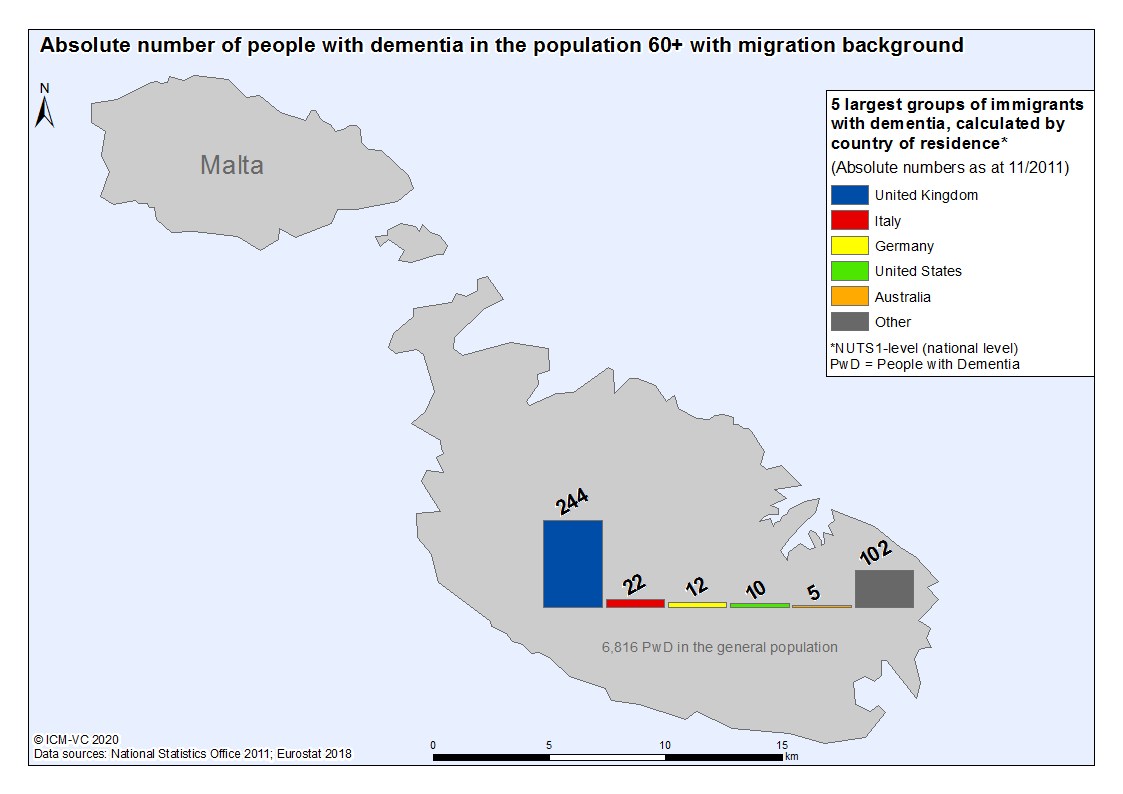EU-Atlas: Dementia & Migration
| Largest group | 2. largest group | 3. largest group | 4. largest group | 5. largest group | |
| Absolute numbers | |||||
| PwMD per 100,000 inhabitants 65+ |
| Absolute numbers | PwMD per 100,000 inhabitants 65+ | |
| Largest group | ||
| 2. largest group | ||
| 3. largest group | ||
| 4. largest group | ||
| 5. largest group |
| Prevalence per 100,000 inhabitants 65+*, calculated by country of residence | |||
|---|---|---|---|
| high > PwMD |
minor > - PwMD |
||
| increased > - PwMD |
low ≤ PwMD | ||
| medium > - PwMD |
|||
| PwMD = People with a Migration background with Dementia *Bulgarien, Litauen, Malta, Polen in der Bevölkerung 60+ |
|||
| Absolute number of PwMD 65+ | |
| PwMD per 100,000 inhabitants 65+ |
Malta
The Maltese islands have a long migration history1 due to their geographical location in the centre of the Mediterranean Sea and the British colonial rule, which lasted for 164 years until 1964. After being an emigration country Malta developed into an immigration country in the course of the 20th century1 due to for example the Second Gulf War, the collapse of Yugoslavia1, accession to the EU2 and asylum seekers1,3. The migrant population of Malta (born abroad) more than quintupled between 1990 and 2019 (15,100 to 84,900). At the same time, the proportion of migrants in the total population has increased from 4.2 to 19.3%4.
There are 5,700 people with a migration background aged 65 or older. Of those, approx. 400 are estimated to exhibit some form of dementia. Calculations show the most affected migrant groups presumably originate from Great Britain (approx. 200), Italy (approx. 20), Germany (approx. 10), the US (approx. 10), and Australia (approx. 10)5.
The ‘National Strategy for Dementia in the Maltese Islands 2015–2023’ from 2015 has 132 pages and addresses the topics of definition of dementia, types of dementia, dementia risk and protective factors, the burden of dementia, financial consequences of dementia, the perspective of people with dementia and their caregivers, dementia awareness, early diagnosis and intervention, drug and non-drug interventions, community-based care services, long-term and palliative care, ethical aspects related to dementia management and care, and research. The topic of migration is absent6. Malta published the three-page guideline 'Dementia Treatment' in 2012. This document deals exclusively with the drug treatment of dementia using donepezil. In this context, no reference to migration is made in it7.
References
- The People for Change Foundation and Integra Foundation: Migration in Malta: Country Profile 2015. In. Geneva: International Organisation for Migration; 2016.
- Cassar CM: Researching Migration and Asylum in Malta: A Guide; 2013.
- St. John J, Delicata M, Azzopardi M: The Organisation of Asylum and Migration Policies in Malta. In: National Report 2008. European Migration Network Malta; 2008.
- International Organisation for Migration: International migrant stock as a percentage of the total population at mid-year 2019: Malta; 2019.
- National Statistics Office: Census of Population and Housing 2011: Final Report. In. Valletta: National Statistics Office; 2011.
- Parliamentary Secretariat for Rights of Persons with Disability and Active Ageing: Empowering Change: A National Strategy for Dementia in the Maltese Islands 2015-2023; 2015.
- Azzopardi Muscat N: Dementia Treatment. In. Edited by Office of the Chief Medical Officer; 2012.


![[Translate to Englisch:] Logo RBS [Translate to Englisch:] Logo RBS](/fileadmin/_processed_/9/7/csm_RBS_Logo_RGB_0e245a98a4.jpeg)